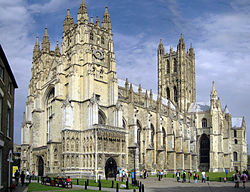Central churchmanship
This article needs additional citations for verification. (April 2012) |
| Part of a series on |
| Anglicanism |
|---|
 |
|
|
Central churchmanship describes those who adhere to a middle way in the
The term is used much less frequently than some others as Anglicanism polarized into Anglo-Catholic and Evangelical/Reformed wings.
In The Claims of the Church of England, Cyril Garbett, Archbishop of York, used the term along with Anglo-Catholic, liberal, and evangelical as a label for schools within the Church of England, but also states:
Within the Anglican Church are Anglo-Catholics, Evangelicals, Liberals and the great mass of English Churchmen who are content to describe themselves as Churchmen without any further label.[1]
History
The term came into use in the late nineteenth century when traditional high churchmen decided to distance themselves from Anglo-Catholicism that came out of the Oxford Movement.[2] With the Oxford Movement being even "higher" than them they first called themselves "Old High Church", but after failing to stop the rise of Anglo-Catholicism they adopted the Center position.
F. A. Iremonger places William Temple among this group emphasizing that Temple had a firm hold on the articles of the historic creeds and a conviction that what is best in each school of thought within the church is worth conserving.[3]
Perhaps the best-known exponent of the central churchman position in the twentieth century was
Since the 1970s central churchmanship as a distinct school of thought and practice within the Church of England has been in decline. This is partly due to the closure or merger of some theological colleges that used to favor the Central position—namely, Wells Theological College, Lincoln Theological College, and Tenbury Wells—and a drift towards theological liberalism, or Affirming Catholicism in others.
Difference with "Broad Church"
Traditionally "broad church" was called Latitudinarianism which supported a broad-based (sensu lato, with "laxitude") Anglicanism where many views were allowed. At the time, this position was referred to as an aspect of low church (in contrast to the high church position, of which the center church is an aspect of). While always officially opposed by the Anglican church, the latitudinarian philosophy was, nevertheless, fairly dominant in 18th-century England.
In modern
Whereas those of Center churchmanship were tightly bound, and believed others should be as well, to the doctrine of the prayer book rubrics which they did not deviate from in either
Practice and Theology
Central churchmen value both the official liturgies of the Church of England, which they clothe in a moderate amount of ceremony and a characteristically Anglican way of doing theology that is rooted in the Bible and the Creeds of the Early Church, whilst also valuing the contribution made by the English Reformation. In their theological thinking, they steer a middle course between the Anglo-Catholic and Evangelical parties,[6] both of which are perceived as being extreme by Central Churchmen.
Theology for Central Churchmen is very much a continuation of the Old High Church. Central Churchmen basically follow the line of development that begins with John Jewel, through Richard Hooker to William Laud and the Caroline Divines, and then on to eighteenth and nineteenth century High Churchmen like Daniel Waterland, William Van Mildert, Harold Browne, Christopher Wordsworth. Central Churchmen are Sacramental Arminians in outlook, believing that baptism confers regeneration, that one can leave the faith if one apostatizes, Election is Corporate and that Christ is truly spiritually present in the elements of Communion. They also hold with a mild form of the doctrine of Apostolic Succession, and are not Charismatic. [7]
References
- ^ Garbett, Cyril (1947). The Claims of the Church of England. London: Hodder & Stoughton. pp. 13, 26.
- ^ Chadwick, Owen (1972). The Victorian Church (Part II). London: Adam & Charles Black. p. 357.
- ^ Iremonger, F.A. (1948). William Temple. Oxford: Oxford University Press. p. 494.
- ^ Cross; Livingstone, eds. (1974). "Broad Church". Oxford Dictionary of the Christian Church. London: Oxford University Press.
- ^ Hylson-Smith, Kenneth (1993). High Churchmanship in the Church of England. Edinburgh: T&T Clark. p. 339.
- ^ McGrath, Alister (1993). The Renewal of Anglicanism. SPCK. p. 112.
- ^ Browne, Edward (1874). An Exposition of the Thirty-nine Articles: Historical and Doctrinal. E.P. Dutton.
